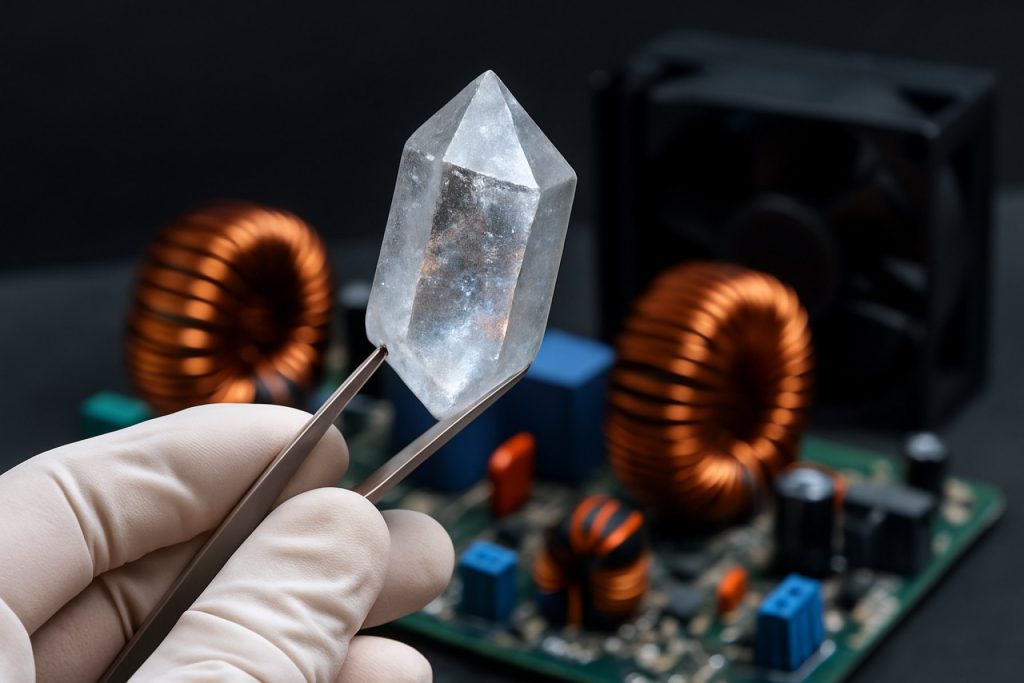
- Diamonds engineered with nitrogen-vacancy (NV) centers are revolutionizing quantum sensors, offering high-precision mapping of energy losses in power electronics.
- Two protocols, Qurack (Qubit Frequency Tracking) and Qdyne (Quantum Heterodyne), enable wide-range frequency detection—from 100 Hz to 2.34 MHz—for detailed analysis of electronic currents and magnetic fields.
- These quantum sensors unveil both efficient and loss-prone energy flow patterns in soft magnetic materials by directly observing magnetic domain wall movements.
- Such insights are crucial for developing sustainable, high-speed, and ultra-efficient electronic devices, including next-generation memory and quantum spintronic systems.
- Ongoing advances in quantum sensing technology will further extend the capability to optimize electronics for minimal energy waste, supporting the future of sustainable technology.
Tokyo’s scientific heart beats faster these days, as shimmering gemstones—the type you might slip onto a finger or string around a neck—are quietly powering a revolution in how we see and shape the future of sustainable technology. Deep within the labs of the Institute of Science Tokyo, diamonds prove their worth not in jewelry, but as quantum sensors capable of exposing the long-concealed energy losses within high-frequency power electronic circuits.
At the heart of this innovation is the nitrogen-vacancy (NV) center, a rare, atomic-scale defect found in diamonds. When precisely engineered, these NV centers transform each diamond into the eyes and ears of magnetic fields, mapping the otherwise invisible landscapes through which electrons surge. Imagine a city in motion seen only by its shadows—quantum imaging, with its exceptional spatial clarity, brightens every hidden corner.
The team, guided by Professor Mutsuko Hatano, crafted two groundbreaking sensing protocols. Their “Qubit Frequency Tracking” (Qurack) acts like a virtuoso violinist, exquisitely sensitive to the subtle, lower notes of kilohertz frequency. Meanwhile, “Quantum Heterodyne” (Qdyne) rises toward the dizzying heights of the megahertz range, unravelling the energetic rhythms of rapid currents. By weaving these techniques together, researchers charted a vast expanse: from the slow pulse of 100 Hz to the high-energy beats at 2.34 MHz.
Using a precisely wound coil and whisper-thin sheets of CoFeB-SiO₂, the scientists peered into the material’s soul. Along one magnetic axis, the quantum sensors revealed a near-perfect tango—magnetization and current in lockstep up to 2.3 MHz, nearly erasing energy loss. But shift the gaze toward the easy axis, and the dance faltered; here, energy quietly slipped away, dictated by the subtle structure of the material’s magnetism.
Beyond merely watching, the NV centers enabled observation of domain wall motions—the minute, collective marches of atomic magnetic moments. These local shifts, long theorized but seldom mapped in situ, are now revealed as root causes of energy dissipation, especially as electronics demand ever-increasing speeds.
The implications stretch far beyond laboratory benches. Mastery of these magnetic microcosms is vital for building faster, smaller, and greener power systems, from swift-charging devices to futuristic applications like non-volatile memory and quantum spintronics. Optimized soft magnetic materials will underpin the compact, ultra-efficient electronics powering tomorrow’s society.
Researchers are not resting. Upgraded signal generators and ever-faster quantum controls will push the boundaries even further, broadening the diamond’s vision into more challenging frequency realms. Each technological leap draws us closer to electronic devices that waste less, last longer, and support a planet striving for energy sustainability.
This breakthrough in quantum sensing puts diamonds—not just a symbol of elegance, but now ingenuity—at the core of modern electronics. Follow new advances in quantum technology and sustainable electronics at Institute of Science Tokyo and global science news destinations such as SpaceMart.com.
Takeaway: Harnessing the unique properties of quantum diamonds unlocks a previously hidden world of microscopic energy dynamics. As the march toward efficient and sustainable technology accelerates, the fusion of quantum sensing and smart materials may be our clearest path forward.
The future will be measured—with diamond precision.
Diamonds Go Quantum: How Tokyo’s Labs are Powering the Green Tech Revolution with Gemstone Sensors
Tokyo’s Institute of Science is pushing the boundaries of what diamonds can do—way beyond their traditional sparkle. By tapping into the quantum world, researchers have deployed diamond-based sensors to map and tackle hidden energy losses in high-frequency power electronics. But the real story doesn’t end with new protocols and impressive megahertz ranges—there’s a sea of untapped potential, industry disruption, and practical applications that this research unlocks.
What Are Diamond NV Centers—and Why Do They Matter?
Nitrogen-vacancy (NV) centers are atomic-scale defects where a nitrogen atom replaces a carbon atom adjacent to a vacancy in the diamond lattice. These centers are prized in quantum science because they can detect minute magnetic fields and be manipulated at the quantum level—even at room temperature. Their unique quantum properties allow for ultra-high sensitivity without extreme cooling requirements that hamper other quantum sensors (Institute of Science Tokyo).
- Uses in Quantum Computing: NV centers are not just for sensing—they’re active candidates for creating qubits in quantum computers due to their long coherence times.
- Biomedical Imaging: They’re also investigated as minimally invasive sensors for measuring magnetic fields at the cellular and even molecular level (SpaceMart.com).
Key Features, Specs, and Technological Advantages
- Frequency Range: From 100 Hz to 2.34 MHz, far surpassing many previous magnetic field mapping technologies.
- Non-invasive Sensing: Analysis without damaging the material or interrupting electronic processes.
- Room-Temperature Operation: NV centers working at non-cryogenic temperatures make this technology viable for everyday devices.
- Spatial Resolution: Quantum diamonds can detect changes at the nanoscale, revealing phenomena invisible to conventional sensors.
How-To: Using Quantum Diamond Sensors for Energy Loss Analysis
- Prepare Diamond Material: Precisely engineer NV centers in synthetic diamond chips.
- Integrate with Electronics: Position diamond sensor close to (or within) the circuit or material under study.
- Use Quantum Protocols: Deploy Qurack for low-frequency signals and Qdyne for high-frequency detection.
- Analyze Data: Visualize magnetic signatures, mapping energy losses or inefficiencies at critical points.
- Implement Feedback: Apply learnings to redesign or optimize electronic components.
Real-World Applications: From Industry to Everyday Life
- Electric Vehicles: Optimize motor efficiency, leading to longer ranges and fewer charge cycles.
- Consumer Electronics: Design thinner, cooler, and more efficient smartphones, tablets, and laptops.
- Renewable Energy Systems: Improve inverter efficiency in solar and wind power conversions.
- Non-volatile Memory and Spintronics: Accelerate next-gen computing with ultra-low energy losses.
Market Forecasts & Industry Trends
The quantum sensing market is projected to grow at over 12% CAGR through 2030, buoyed by applications in defense, biomedical diagnostics, and (critically) high-efficiency electronics. As the world transitions to electrified transport and renewables, efficient power management becomes pivotal. Quantum diamond sensing may become a mainstream tool across manufacturing and R&D by the late 2020s (SpaceMart.com).
Controversies & Limitations
- Production Costs: Synthetic diamond fabrication remains expensive and requires highly controlled environments.
- Scalability: Integrating diamond quantum sensors into mass-produced devices is still in its infancy.
- Signal Processing Demands: The quantum protocols generate massive amounts of data, demanding sophisticated interpretation and computational resources.
Security & Sustainability Insights
- Cybersecurity: Quantum sensors, thanks to their precision, offer potential for tamper-proof surveillance in sensitive electronic systems.
- Eco-friendliness: Unlike rare-earth magnets or heavy metals, diamonds (especially synthetically produced) are more sustainable and recyclable.
Reviews & Comparisons
Compared to traditional Hall sensors or SQUIDs (superconducting quantum interference devices), diamond quantum sensors offer higher spatial resolution, broader frequency range, and ambient operation—making them superior for many industrial, biomedical, and research applications, albeit at a higher upfront cost.
Compatibility & Future Integration
- With Silicon Chips: Early research suggests integration of diamond layers and NV centers into commercial chipsets is feasible but complex.
- AI Synergy: Quantum sensor data can feed directly into AI-driven optimization platforms for real-time system management.
Top Reader Questions—Answered
- Are these diamonds natural? No, they’re typically lab-grown for optimal purity and control of NV center placement.
- Will this tech be in consumer products soon? While industrial deployments are close, consumer-level integration may be several years away pending miniaturization and cost reductions.
- Can diamond sensors replace all other magnetic sensors? Not yet. For mass-market, low-precision, or cost-sensitive applications, other sensor types might remain preferable.
Pros & Cons Overview
Pros:
- Unmatched sensitivity and precision
- Non-invasive, non-destructive sensing
- Room temperature operation
- Potential for sustainability gains
Cons:
- High material and manufacturing costs
- Integration challenges
- Data complexity
Quick Actionable Recommendations
- Stay Informed: Track developments via Institute of Science Tokyo and quantum tech news outlets for integration breakthroughs.
- Evaluate Use Cases: If working in electronics, materials science, or renewable energy, consider pilot testing quantum diamond sensing for R&D optimization.
- Advocate for Sustainability: Opt for or develop components that prioritize energy efficiency and quantum-level insights.
- Upskill: Electronics and material engineers should explore quantum sensing workshops to prepare for upcoming industry shifts.
Bottom Line: Quantum diamond sensors are rewriting the rulebook for sustainable tech and electronics. Their adoption could dramatically improve the energy wastage landscape, making a measurable difference—with diamond precision. The Institute of Science Tokyo and quantum tech pioneers will be at the center of this transformation. Stay tuned—and stay sharp!



